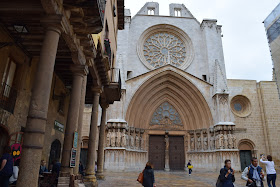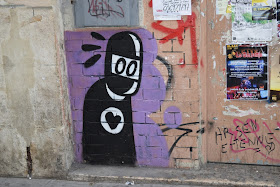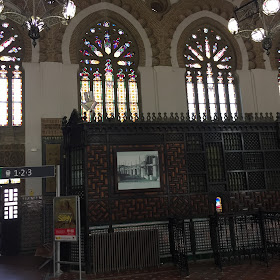Next stop Toledo. If I could manage it, that is: the brave concierge at my hotel spent 2 ½ hours negotiating the Renfe website trying to get a ticket, and the best he could do was to get a confirmation number for me to show the ticket agent. To be honest, if the cabbie hadn't taken me through the park, I would have known how close the station really was and done it in person, but we agreed it was an educational experience and he might be asked to do it again.
That said, I walked down to the train station, bid the turtles a brief adios, and got on a train that took a bit over an hour to get to Toledo. Again, the scenery was almost nonexistent, but once we got there, it was obvious why a city had grown up there, surrounded as it is by a river. But the first thing I had to do was get out of the train station. That was easy enough, but the station was gorgeous.
Although compared to the rest of the city the station is obviously recent, it deliberately recalls the work of the Mudéjars, Muslims who stayed in Spain after the
reconquista, the taking of the former Arab state of al-Andaluz by the Spanish. This, and the vibrant Jewish community the city had supported, was part of what I came to see.
 |
| Yawn. Another city on another hill. Taken near the railroad station. |
This time the cab driver took me through the park again, but he had to: Toledo is seriously pedestrianized, and its drivable streets aren't real intuitive. I'd picked my hotel carefully: it was the only one that mentioned that it was in the heart of the old
judería, the Jewish neighborhood, which proved to be a smart place to be from a number of viewpoints. For one thing, it was away from the tourist crush. For another thing, signs all over town point to the synagogues, and just a few feet away was the Maria Blanca synagogue, which I hustled off to see. This had been built by the Mudéjars for the local Jews and then, after the Expulsion, had been turned into a church dedicated to the purity of the Virgin by a fanatical priest. Now it's been reclaimed as a historical monument, and the Arab influence is everywhere.
 |
| The main sanctuary is marked off by these pillars |
Outside, there's a small building with an art gallery in it, and that's where I headed next. A friend in Austin had told me that a friend of hers sometimes worked there, spoke English, and gave a great tour of the
judería if you asked for an appointment. Her name is not Naomi, so that's what I'll call her: tour guides are heavily regulated in Toledo, mostly for good reasons (and there are tons of tourists on tours you'll encounter as you walk the streets). Leading an unlicensed tour can get you a massive fine, so if you're headed to Toledo and want the tour, let me know and I'll let her know. We made an appointment for the next day.
I had the rest of the day to wander around. The medieval city part of Toledo -- the part on the hill -- isn't all that large, and my next stop was the Sephardic Museum, housed in another former synagogue, El Tránsito.
 |
| Impossible to photograph the main room, but I tried |
 |
| Upstairs there was this room with these inscriptions. I later learned that the inscription in the roundel was probably Hebrew, but written in Arabic script! |
The inside of this synagogue reflects the wealth of Samuel Levi, who built it (and was later murdered by the king, Pedro the Cruel, who seized his money) and here again the Arabic influence is everywhere. The museum itself tries a bit too hard, presuming no knowledge of Judaism whatever, which, for Spanish visitors, might be true. It's remarkable, though, that as much of the original decoration and structure remains, and it's worth the couple of Euros it costs to get in just to wander around and gaze.
From here I wandered around a bit, going up the hill and looking for other sites that might fill me in on the city's history. My advice is to be careful: even the city-sanctioned sites can be a ripoff. There was a (non-sanctioned) museum in a former monastery dedicated to the Cathars and other sacred military orders who participated in the Crusades. It's run by a crazy deaf guy who hands you a book of translations of the captions on a bunch of pictures set up in the main part of the museum. Not a single authentic artifact around: it appears to be run by a company that produces ripoff "museums" like this and the inevitable Museum of Torture you find in various European cities. You'd learn more from a magazine article on the Crusades. But the church of El Salvador, which
is sanctioned, is just as much of a ripoff. It advertises itself as an archeological site with Visigothic and Arab elements, but you go in and walk into the courtyard and up some stairs and see a bunch of stones with no labelling to tell you what they are. You emerge €2.50 poorer and no wiser.
It was okay: I'd already paid the fake Crusader museum €2.50, and I was learning my way around this part of town. I'd eaten lunch next to a church where Toledo's most famous Christian, El Greco, had a painting (didn't go in: €2.50 saved), and marvelled at the huge number of souvenir shops selling swords (Toledo blades! A sign in the train station warns that you might not be able to take "certain souvenirs" as carryon luggage, and this is what they mean) and knives and lots and lots of bits of
damasqueño, gold-inlaid steel, an art brought to the city by Jews from Damascus. I came close to the cathedral, but managed to miss it, and the afternoon was ending, so I headed back to the hotel to start to think about dinner.
A quick search on the web indicated that there wasn't much in the
judería (and none of it kosher, not that that was an issue for me), but a restaurant called
La Orza looked good. I used TripAdvisor's Fork app to make a reservation and went off at the appointed time. Turned out that Fork had made the reservation for the next night instead, but after a bit of sniffing, they found me a table next to a gaggle of obnoxious Germans who alternated their time between arguing which was the best Kenny G album and berating the waiter over various allergy issues. I alternated between hating them and marvelling that my German came back so quickly. But the food was spectacular: a "carpaccio" of fresh boletus mushrooms studded with some kind of truffle cream and a loin of venison with a not-too-sweet glaze. The wine was just as good: a locally-grown wine called
Martúe, which will set you back a whopping €6.80 in the local stores and is a stunning blend of Syrah, Cabernet, Merlot, Tempranillo, and Petit Verdot.
The next day at noon, I met Naomi in front of Maria Blanca, and was treated to a tour of the invisible
judería. It's invisible, of course, because of 1492, the year Ferdinand and Isabella, co-rulers of a newly-unified Spain, ordered all the non-Christians out of the country, an order that was enforced by the Vatican's faith police, aka the Inquisition. Convert or leave was the order, and many agreed to convert, at least on the surface. It was the Inquisition's job to prove those conversions by trying those accused of continuing to practice Jewish rituals, a practice known as auto-da-fé. If you got that far, you were probably going to be sentenced to death.
According to Naomi, it's thought that the first Jews on the Iberian Peninsula came with Phoenician traders, and stayed on to form an infrastructure for traders. The Romans also brought Jews, who did business tasks, including banking. (I've always loved the fact that Cologne had Jews before it had Germans: it was a Roman colonial administrative center from which the Germanic tribes were, for obvious reasons, excluded). The conquest of Iberia by the Arabs didn't change much: their Islam had been coexisting with Judaism in northern Africa, and the two cultures' preoccupations -- theology, philosophy, mathematics, astronomy, medicine -- meshed pretty well, although the Jews honed in on medicine and their kabbalistic studies had an impact on astronomy/astrology that helped the Arabs' Mediterranean seafaring become more accurate. Toledo had a whole section of its
judería that consisted of nothing but kabbalistic synagogues and midrashes (schools). The
reconquista forced the Arabs to convert eventually (although as the tons of Mudéjar work in Toledo shows, not immediately), but since the Jews were sequestered in the
judería (both by decree and choice), they stayed on until 1492.
Naomi made an interesting point that I hadn't considered: Christian children were by and large not educated unless they were of the ruling classes. Education was paramount in Arab and Jewish society: madrassas and midrashes (notice the similarity in the terms) provided an education for all children, and in the
judería, at least, wealthy Jews subsidized the less well-off. In this way, a bright but poor Jewish kid could ascend the ladder of society, lifting his family with him. No wonder the Christian rabble feared and despised them, and the Jews built walls to control who could get in and out of their community, and when.
As we walked the back streets of the judería, Naomi's x-ray vision saw through walls and floors, illuminating very ordinary-seeming things. The wall behind Maria Blanca, for instance, was oriented towards Jerusalem, and after the Expulsion,
conversos, the nominally Catholic former Jews, would touch it surreptitiously. Secret signs pointed to a house with a well in it, essential for fire control in the
judería.
 |
| This ball is just one of several well signs; once you know about them, you see them everywhere in the júderia. |
A set of chains is a secret memorial for a Jewish blacksmith who lived in that house and was ordered to forge them to bind prisoners headed to the auto-da-fé -- many of whom were Jews.
Naomi saw through floors: the cellars of the Jewish houses housed some Jews before they could get out of Spain, and many of them buried their treasures there, confident Spain would let them back in. A house in the former
judería, then, became a hot item on the post-Expulsion real estate market: Jews were forbidden to take money or gold out of the country when they left, and everyone just
knew there were giant hoards of gold in thoes cellars. And there may have been, but the most recent item to emerge from a cellar was a tattered Torah, displayed in the Sephardic Museum.
Some Jews didn't go far: many
conversos settled in the hills outside of Toledo, forming all-Jewish -- excuse me,
converso -- communities who, over time, forgot about their heritage, at least a little bit. Naomi's visited some of them, and found a baker in one who made an egg bread on Saturdays that, for some reason, always sold out. Why make it then? Why does it sell out? It's a dimly-remembered challah, made with eggs to keep it moist over the Sabbath, when you can't bake a new loaf. A few Spanish scholars are beginning to look into this, and a trickle of money from Israel is helping out.
Most of Naomi's tour didn't lend itself to photographs: the Jews of Toledo are mostly ghosts by now. Even Naomi isn't Jewish by tradition: her father was a Sephardic Jew, but her mother isn't, and Jewish descent is matrilineal. I'm pretty sure she's officialized her Judaism by now; her passion for the subject shows a deep internalization of an ethos that exists proudly in a small number of Spaniards in the 21st century.
All over the
judería, I noticed tiny tiles set into walls and paths.
 |
| Sefarad |
 |
| The name of God |
 |
| The mysterious menorah |
I didn't quite get Naomi's explanation of this, but the top one, when all of them are mapped onto a map of Toledo, forms a map of Sefarad, the Jewish name for the Iberian Peninsula. The city did this project to promote the Jewish heritage of Toledo, but they botched it badly: they placed them on the roadway, under trash baskets, and other inappropriate places: no observant Jew would tread on the name of God, but lots of nonobservant tourists (including me before I heard the explanation) would and did.
I was astonished how much I'd learned in a short time, and Naomi had to get back to work and pick her daughter up from school, so I thanked her profusely and gave her a tip, and wished her luck in her ongoing research into a subject that was actually pretty taboo until just recently. As I wandered off, in search of the El Greco House and lunch (not necessarily in that order) it occurred to me that Toledo's really missing a bet not marketing the judería to American Jewish tourists, but later I realized that American Jews are overwhelmingly Ashkenazi (Eastern European and, according to Naomi, more focused on rules and laws), not Sephardic (more focused on mysticism and science, she said). Before I could muse further, an outdoor
cervesería with inviting food hove into view, and I sat. Lunch was a mind-blowing thing called a
timbal de codorniz, which Google seems to have as any round, layered cold tapa. Mine had (I think) pickled rabbit and green peas in an aspic and was just what the doctor ordered.
It turned out that the El Greco House was just past the Sephardic Museum, and by this point I figured I had to give the Christians a little something of my time, and if there was a Toledan Christian deserving of it, it would be El Greco, who was, as his name shows, a Greek from Crete who came to Spain after training in Venice. He was sure that with his skills, he could get all kinds of gigs, especially in what was then the capital of Spain. He was wrong: the very things that make people consider him a master today repelled the authorities, and although he kept on painting, he never made as much money as his more conventional contemporaries. His stock was at an all-time low when the Toledan Marquis of Vega Inclán decided to celebrate him by turning El Greco's house into a museum. There were a couple of hitches: the property wasn't actually El Greco's former house (nobody seems to know where it was), and it turned out not many of his paintings were available to buy, since they were in the Prado, the Metropolitan Museum, and elsewhere. The Marquis got what he could, including a full set of portraits of Jesus and the Apostles (there's another set by El Greco, more conventional in style, in, I think, the Cathedral), slapped them into the house, threw in some period furniture, and then discovered that the house had been built over Samuel Levi's house, and its cellar was intact. (Did he find anything there? Who knows? But it's notable that although it's set back from the road, the museum is next door to the Sephardic Museum in the synagogue Levi built: €5 gets you a ticket to both). I was dead tired from walking by now, and just two blocks from my hotel, so I went back and crashed for a while.
When I woke up, I decided to walk to the train station to get my next day's tickets to Valencia. I exited through the Jews' Gate and walked twenty minutes to the station, got my ticket to Madrid and then Valencia (the guy wouldn't book me on the Valencia train that was eight minutes after the Toledo train got in -- gotta love ol' Renfe! -- so I'd have to spend an hour with the turtles), and walked back via the upper old town, where the Alcázar, the huge fort, was, getting there via a very convenient network of escalators, a very civilized way to ascend to that part of town.
 |
| Obviously not the Jews' Gate any more... |
That night, I ate at the hotel's restaurant, which was actually pretty good. I had partridge, which is the city's signature dish, and I would have enjoyed it more if it weren't the gaspergoo of the avian world: like the Cajun alleged-delicacy, it seems to have thousands of bones.
The next morning I had a bit of time, and went next door to the hotel and wandered through what I could of the church of San Juan de los Reyes, built to commemorate the union of the kingdoms of Aragon and Castille through the marriage of Ferdinand and Isabella. Built on the site of the kaballists' neighborhood, it apparently has chains liberated from the Christian slaves in Arabic Granada when it was liberated, but all that was open was a chapel and the cloisters, which show more Mujédar influence, its origins long lost to those who built it. Or were they?
Soon enough, it was time for a cab to the station. Next up, Valencia, and more Arabs, Jews -- and Romans, too.
 |
| 'Bye, Toledo |


























































